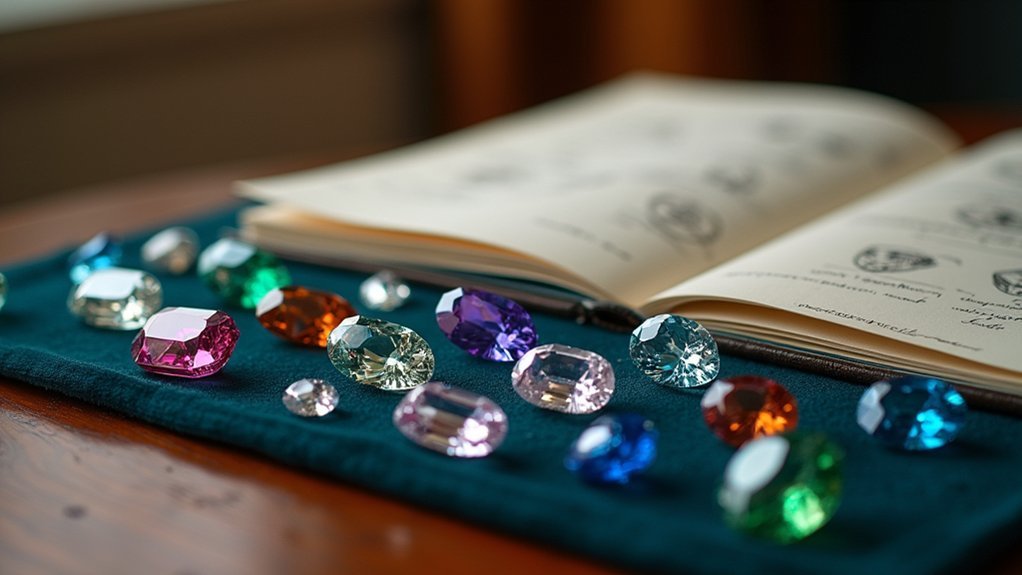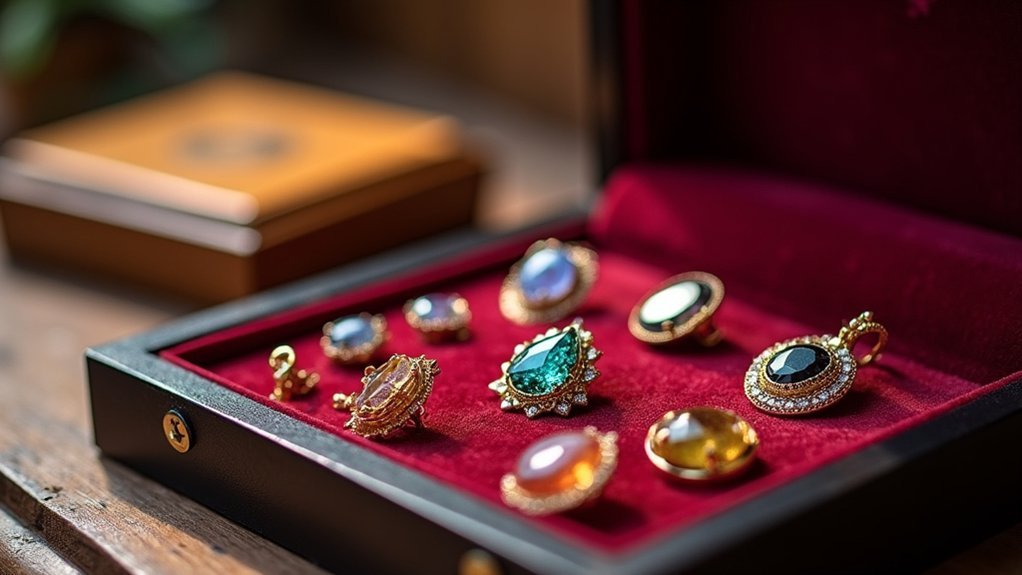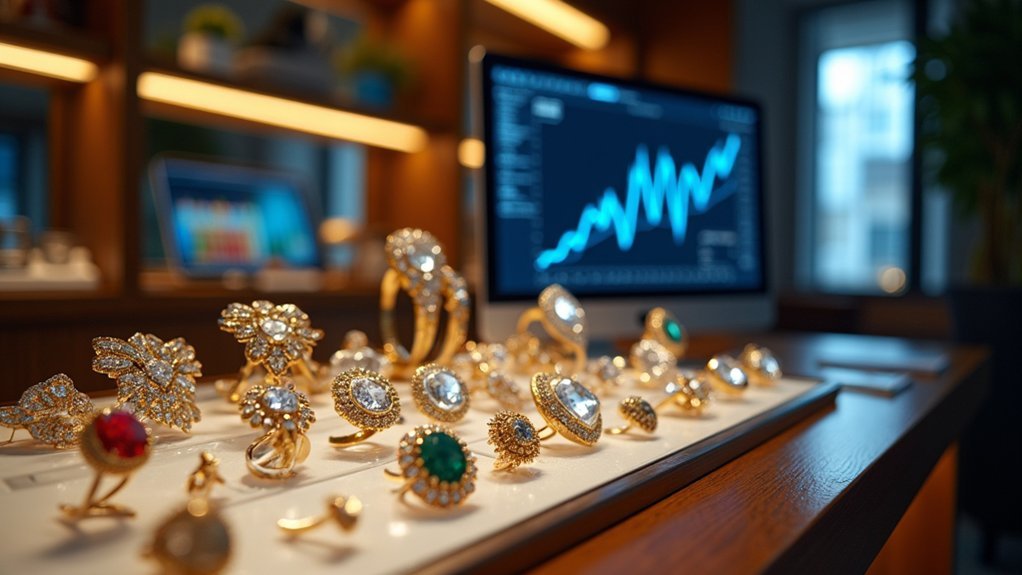You’ll boost your jewelry sales by mastering product knowledge and conducting detailed quality assessments that build customer trust. Research your target audience to identify unique selling points, then implement strategic pricing with 50-100% profit margins based on competitive analysis. Build a strong online presence through professional websites and social media engagement, while creating emotional connections through storytelling in product descriptions. Focus on customer retention with personalized service, loyalty programs, and follow-up maintenance services that’ll transform your marketplace success when you explore these extensive strategies.
Master Your Product Knowledge and Quality Assessment

When you’re selling jewelry in today’s competitive marketplace, your deep understanding of each piece’s unique features and craftsmanship becomes your most powerful sales tool.
You’ll build trust and confidence by communicating intrinsic value through detailed knowledge of materials, design elements, and overall condition.
Conduct thorough quality assessments of every item you’re selling. Your familiarity with gemstones and precious metals enables you to answer customer questions confidently, showcasing what makes each piece special.
This time investment in quality assessment directly impacts customer decision-making, as higher quality correlates with increased satisfaction and repeat business.
Seek regular expert consultations to enhance your assessment skills and stay informed about market trends.
This knowledge keeps your jewelry marketing competitive while ensuring accurate product representation that drives sales success.
Identify Your Target Audience and Unique Selling Points
How well do you truly know the customers who’ll treasure your jewelry pieces? Understanding customer demographics like age and income lets you tailor marketing strategies and products to your target audience’s specific needs.
You’ll want to conduct market research identifying which segments resonate with each piece you’re selling.
Your unique selling points set you apart in this competitive marketplace. Highlight craftsmanship quality, material significance, or the compelling story behind each creation.
In a saturated jewelry market, your unique craftsmanship, meaningful materials, and authentic story become the differentiators that compel customers to choose you.
These differentiators help customers understand why they should choose your pieces over countless alternatives.
Don’t underestimate storytelling’s power in product descriptions. Creating emotional connections through narratives increases purchase likelihood.
Engage directly with customers to understand their shopping behaviors and preferences, then adapt your offerings accordingly to exceed their expectations.
Develop Strategic Pricing for Maximum Profitability

Since your jewelry’s perceived value directly impacts purchasing decisions, strategic pricing becomes the cornerstone of sustainable profitability.
Calculate your production costs—materials, labor, and overhead—then add a 50-100% profit margin to guarantee sustainability. Research competitors regularly to understand market trends while maintaining your unique value proposition.
Implement tiered pricing strategies targeting different market segments. Offer premium pieces at higher price points alongside affordable options to broaden your customer base.
Use psychological pricing techniques like ending prices in .99 or .95 to create value perception.
Monitor sales data and customer feedback continuously. This allows you to refine your strategic pricing approach, making sure it aligns with market demand and customer expectations for maximum profitability in competitive marketplace environments.
Conduct Thorough Competitive Market Analysis
You need to systematically research your competitors’ pricing strategies to understand how they position their jewelry in the market and what price points resonate with customers.
Start by analyzing similar products across different platforms to identify pricing patterns, discount frequencies, and value propositions that drive sales.
This research will reveal untapped market gaps where you can position your jewelry offerings to capture overlooked customer segments and maximize your competitive advantage.
Research Competitor Pricing Strategies
Before setting prices for your jewelry pieces, understanding what competitors charge becomes essential for marketplace success. When you research competitor pricing strategies, you’ll discover valuable insights that help you sell your jewelry profitability while remaining competitive.
Start by analyzing similar pieces across local stores and online platforms. Use tools like Google Shopping to monitor price fluctuations and identify trends. Document your findings systematically:
| Competitor | Product Type | Price Range | Discount Strategy | Unique Features |
|---|---|---|---|---|
| Local Store A | Gold Rings | $200-$500 | 10% first-time | Custom sizing |
| Online Shop B | Silver Chains | $50-$150 | BOGO offers | Free shipping |
| Boutique C | Gemstone Earrings | $75-$300 | Seasonal 20% | Handcrafted |
| Platform D | Bracelets | $25-$200 | Bundle deals | Personalization |
| Store E | Necklaces | $100-$400 | Loyalty points | Lifetime warranty |
This data informs strategic pricing decisions that balance competitiveness with profitability.
Identify Market Gaps
While your competitors focus on saturated markets, discovering untapped opportunities through thorough analysis reveals where your jewelry business can thrive without intense competition.
Conduct an extensive SWOT analysis of competitors to uncover market gaps in their product offerings. Study their pricing strategies to identify underpriced categories or premium segments where customers value unique designs.
Use Google Trends and social media analytics to spot emerging jewelry styles competitors aren’t tracking. Survey potential customers about unmet needs that existing businesses overlook. This feedback helps you tailor products specifically for underserved audiences.
Review competitor product reviews regularly to identify common complaints or desired features. These insights reveal market gaps where you can position superior alternatives, ensuring your jewelry business captures overlooked revenue opportunities effectively.
Build a Strong Online Presence and Social Media Strategy

How can jewelry businesses cut through the digital noise to reach their ideal customers?
You’ll need to build a strong online presence that establishes credibility and drives sales. Start with a professional website featuring user-friendly navigation and high-quality jewelry images, since 75% of consumers judge your company’s credibility based on website design.
Your website is your digital storefront—make it count with professional design and stunning product photography that builds instant trust.
Leverage social media platforms like Instagram and Facebook where 83% of users discover new products. Post engaging, visually appealing content regularly and implement targeted advertising—Facebook Ads deliver an average $4 return for every $1 spent.
Respond promptly to comments and messages, as 70% of consumers feel more connected to responsive brands. Create storytelling content about your craftsmanship and materials, generating 3 times more engagement than standard promotional posts.
Utilize High-Quality Photography to Showcase Your Pieces
You’ll notice that proper lighting makes your jewelry’s gemstones and metals sparkle dramatically, drawing customers’ eyes to every brilliant facet.
Your camera should capture the intricate details that showcase your craftsmanship—from delicate engravings to precise stone settings that demonstrate quality.
Don’t settle for single shots when multiple angles can reveal your piece’s full beauty and help buyers visualize exactly what they’re purchasing.
Lighting Enhances Jewelry Sparkle
Since your jewelry’s sparkle can make or break a sale, mastering the art of lighting becomes your most powerful marketing tool.
When you sell jewelry online, proper lighting showcases intricate details and craftsmanship that customers can’t physically examine. Natural light or soft diffused lighting eliminates harsh shadows and reflections that distract from your pieces’ beauty.
Invest in a lightbox for controlled lighting conditions that minimize glare while highlighting gemstone brilliance and precious metal luster. This professional setup creates consistent, appealing images that establish your brand identity.
High-quality photography with appropriate lighting can boost your online sales by up to 30%, as visually striking images capture attention and encourage customers to explore your collection further.
Capture Intricate Craftsmanship Details
Perfect lighting sets the foundation, but capturing every detail requires mastering your camera techniques and equipment choices. You’ll need macro photography to reveal engravings, gemstone facets, and intricate metalwork that standard shots miss. Professional photographers or lightboxes dramatically improve your product photos’ clarity and appeal.
| Equipment | Detail Level | Customer Impact |
|---|---|---|
| Standard Camera | Basic features visible | Low engagement |
| Macro Lens | Fine engravings clear | Medium interest |
| Professional Setup | Every facet sharp | High conversion |
| Lightbox System | Consistent clarity | Trust building |
| Zoom-enabled Images | Interactive viewing | Purchase confidence |
Clean, organized backgrounds eliminate distractions while highlighting your jewelry’s beauty. When you provide zoom functionality online, customers can examine quality closely, influencing their purchasing decisions and building confidence in your craftsmanship.
Multiple Angles Increase Appeal
Multiple perspectives transform browsers into buyers by revealing your jewelry’s complete story. When you showcase pieces from multiple angles, you’re giving customers the confidence they need to make purchasing decisions.
Research shows that listings with varied viewpoints can boost your sales conversion rates by 30%, as buyers feel more informed about their investment.
Don’t just snap one front-facing shot and call it done. Capture your jewelry from above, below, and sideways. Include close-ups that highlight intricate details like engravings or stone settings.
Show the back of pendants, the inside of rings, and how earrings look when worn. Each additional angle you provide builds trust and demonstrates transparency, turning hesitant browsers into committed buyers who appreciate your thoroughness.
Create Emotional Connections Through Storytelling
Every piece of jewelry carries a story waiting to be told, and as a jeweler, you hold the key to revealing these narratives that transform simple purchases into meaningful investments.
When you create emotional connections through storytelling, you’re helping customers envision how your pieces fit into their personal journeys.
Share the backstory behind each design—who crafted it, what materials were chosen, and why. Include customer testimonials that showcase real experiences and transformative moments.
Every design tells a story—reveal the artisan’s vision, material choices, and customer moments that transformed simple jewelry into treasured memories.
Weave in occasions like engagements, anniversaries, or celebrations to help buyers picture themselves wearing your jewelry during their special moments.
Use social media to amplify these stories with compelling visuals. High-quality images paired with authentic narratives build trust and make your pieces irresistible beyond their physical beauty.
Implement Effective Sales and Closing Techniques

While compelling stories draw customers into your jewelry’s world, knowing how to guide them toward a confident purchase decision separates successful jewelers from those who simply showcase beautiful pieces.
Watch for buying signals—customers examining an engagement ring repeatedly or asking specific questions about sizing indicate readiness. Use direct closing techniques like “Would you like me to size this engagement ring for you?” to create urgency without pressure.
Address concerns immediately; if they’re worried about price, highlight payment options or warranty benefits. Don’t let objections linger—resolve them before attempting to close.
After completing sales, implement follow-up strategies through personalized thank-you emails and feedback requests. This approach builds lasting relationships, encouraging repeat purchases and referrals that sustain your marketplace success.
Focus on Customer Satisfaction and Retention Programs
You’ve mastered closing techniques, but your work doesn’t end when customers leave with their purchase.
Building retention program strategies transforms one-time buyers into lifelong advocates who’ll return for future jewelry needs and refer friends and family.
Creating these loyal relationships requires intentional follow-up systems and personalized touches that make customers feel valued long after their initial transaction.
Retention Program Strategies
Since acquiring new customers costs considerably more than retaining existing ones, smart jewelers prioritize building lasting relationships through strategic retention programs. You’ll keep customers coming back by implementing targeted initiatives that demonstrate ongoing value and appreciation.
| Strategy | Implementation | Benefit |
|---|---|---|
| Loyalty Programs | Points system with exclusive discounts | Encourages repeat purchases |
| Follow-up Services | Complimentary cleaning and maintenance | Builds long-term relationships |
| Personalized Communication | Birthday discounts and tailored recommendations | Creates emotional connections |
Create a welcoming atmosphere both in-store and online to guarantee positive experiences that encourage referrals. Gather customer feedback through surveys to continuously improve your service quality. Your personalized communication strategy should include birthday discounts and product recommendations that show genuine appreciation for each customer’s preferences.
Building Loyal Relationships
Building loyal relationships forms the foundation of sustainable jewelry business growth, requiring deliberate focus on customer satisfaction alongside well-executed retention programs.
You’ll strengthen these bonds by implementing follow-up services like complimentary cleaning and maintenance, which keep customers engaged beyond their initial purchase. Create loyalty programs offering discounts and exclusive access to encourage repeat business while demonstrating your appreciation for their continued support.
Actively gather feedback through surveys to identify improvement opportunities and show you’re committed to excellence.
Transform your store into a welcoming environment where personalized shopping experiences leave lasting impressions that drive referrals. Maintain consistent communication through personalized messages and collection updates, ensuring customers feel valued and connected to your brand long-term.
Leverage AI Tools and Team Strategies for Lead Management

While traditional lead management relies heavily on manual processes and business hours, modern jewelry businesses can dramatically increase their conversion rates by combining artificial intelligence with strategic team collaboration.
You’ll sell more effectively by implementing AI chatbots that respond to customer inquiries 24/7, ensuring no potential buyers slip away during off-hours. Use AI-driven analytics to identify high-value customers and customize your marketing approaches to their specific preferences.
Pair team members with complementary sales styles so they can support each other in managing leads and closing deals. Train your staff on AI lead management tools to streamline interactions and improve follow-up efficiency.
Establish feedback systems where team members share insights on successful strategies, creating a collaborative environment that boosts overall sales performance.
Frequently Asked Questions
How to Be Good at Selling Jewelry?
You’ll excel at selling jewelry by understanding each piece’s story, asking customers about their preferences and occasions, creating urgency with limited-time offers, and providing exceptional service that builds lasting relationships.
How Do You Sell Successfully on the Marketplace?
You’ll succeed by researching your target audience, using high-quality photos with detailed descriptions, optimizing listings with relevant keywords, pricing competitively, and engaging promptly with customers to build trust.
What Is the Most Profitable Way to Sell Jewelry?
You’ll maximize profits by selling personalized jewelry on established platforms like Etsy, using high-quality photos and SEO optimization. Target niche communities through social media while offering customizable pieces that command premium pricing.
How to Increase Sales in Jewellery?
You’ll boost jewelry sales by showcasing stunning product photos, targeting specific customers through social media ads, creating urgency with limited offers, personalizing recommendations, and building a user-friendly website with strong SEO optimization.
In Summary
You’ve got the blueprint for marketplace success in your hands. Don’t let these strategies sit idle—take action today. Start with mastering your product knowledge, then build outward to pricing, marketing, and customer retention. Remember, you’re not just selling jewelry; you’re creating experiences and memories. Implement these techniques consistently, track your results, and adjust as needed. Your profitable jewelry business awaits your commitment to excellence.





Leave a Reply